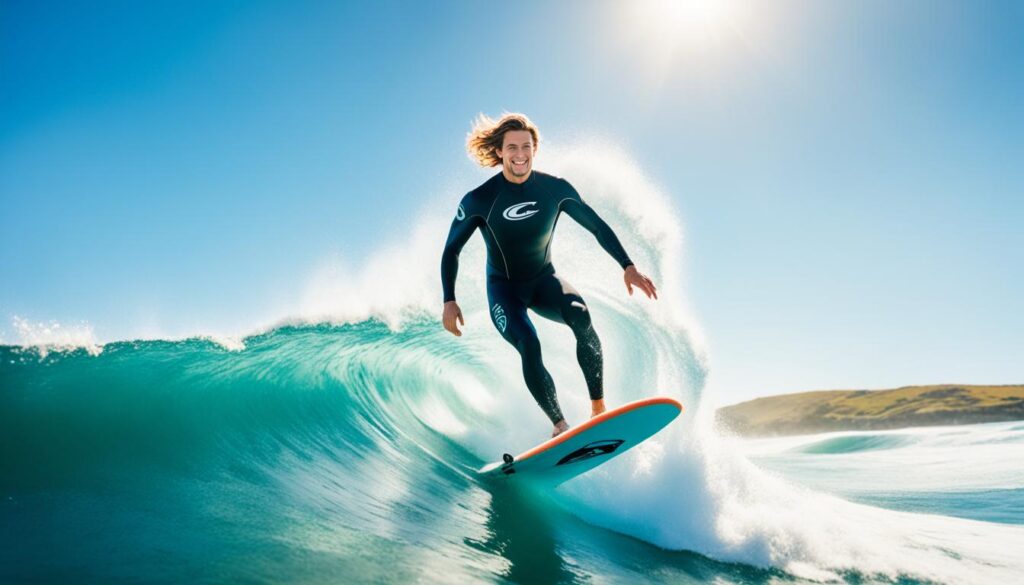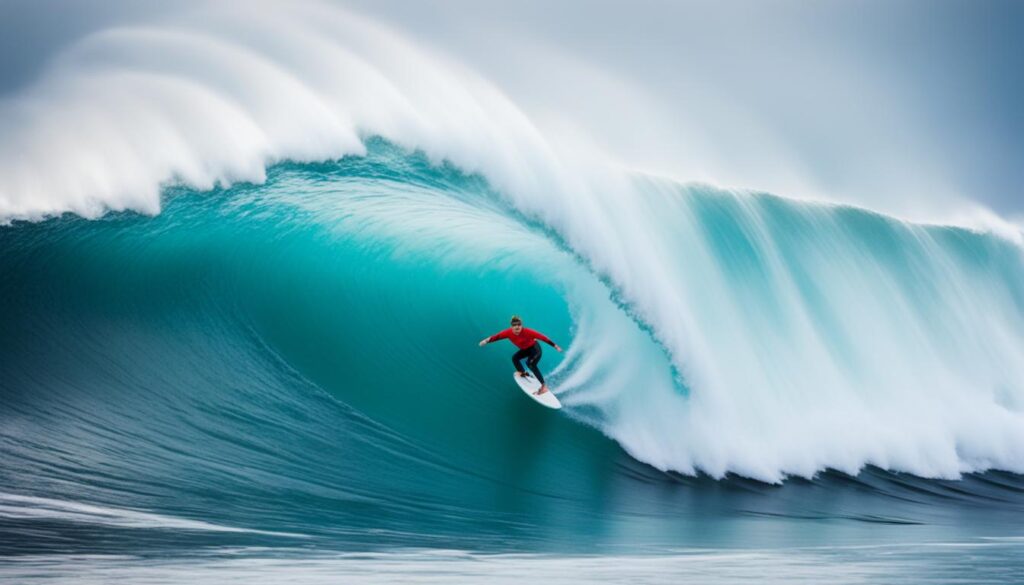Surfing is an exhilarating sport that allows you to ride the waves and experience the thrill of the ocean. But have you ever wondered, are surfboards slippery? The answer might surprise you. In this article, we will explore the truth behind the slipperiness of surfboards and provide you with essential surfing safety tips to enhance your grip and ensure a safe surfing experience.
Key Takeaways:
- Understanding the factors that contribute to surfboard slipperiness
- Tips to improve traction and prevent slipping on surfboards
- The role of surfboard wax and traction pads in enhancing grip
- Choosing the right surfboard for optimal safety and performance
- Staying vigilant and aware in the water to avoid potential hazards
“Top Surfing Safety Tips”
When it comes to enjoying a safe and exhilarating surfing experience, it’s essential to keep some key safety tips in mind. Follow these guidelines to ensure that you have a great time while staying safe in the water:
- Take surf lessons or surf with an experienced friend: Learning the basics of surfing from professionals or experienced surfers can provide you with valuable knowledge about wave dynamics, safety protocols, and proper technique.
- Check current surfing conditions: Before hitting the waves, it’s crucial to assess the current conditions, including wave height, tides, and any potential hazards to identify the best time for surfing.
- Be prepared with a first aid kit and sunscreen: Always carry a well-stocked first aid kit and apply sunscreen with a high SPF to protect your skin from harmful UV rays.
- Warm up before entering the water: Performing stretching exercises and light warm-up routines can help prevent injuries and prepare your body for the physical demands of surfing.
- Wear appropriate gear like wetsuits or rash vests: Wearing a wetsuit or rash vest not only provides insulation but also protects your skin from abrasions and gives you added buoyancy in the water.
- Surf with a friend and let someone know your location: Having a buddy system in place ensures that there is someone to help in case of an emergency. Always inform a trusted person about your surfing plans and expected return time.
- Avoid surfing while under the influence of alcohol or drugs: Surfing requires focus, coordination, and quick reflexes, which can be impaired by alcohol or drugs. Always prioritize an alert and sober state of mind.
- Prepare yourself physically for the demands of surfing: Engaging in regular exercise, strength training, and cardiovascular workouts will help enhance your surfing performance and reduce the risk of injury.
- Follow surfing etiquette: Show respect for other surfers by understanding and adhering to surfing etiquette, such as taking turns, not dropping in on someone’s wave, and communicating effectively in the water.
- Choose beginner-friendly waves to surf: If you’re a beginner, it’s important to select waves that match your skill level. Look for gentle, slow-breaking waves that provide a stable platform for learning and building confidence.
By incorporating these top surfing safety tips into your routine, you can maximize your enjoyment of the sport while ensuring your safety and the safety of others in the water.
“The Importance of Surf Wax”
When it comes to surfing, having a good grip on your surfboard is essential for staying balanced and performing well. That’s where surf wax comes in. Surf wax plays a crucial role in enhancing the grip of the surfer on the surfboard, providing traction that prevents slipping while riding the waves.
To apply surf wax, you simply rub it onto the deck of your board. The texture of the wax creates a sticky surface that improves your ability to grip the board, even when it’s wet. By applying the wax in a criss-cross pattern, you ensure maximum coverage and a reliable grip.
Regularly maintaining and reapplying surf wax is important to ensure optimal grip and performance. Over time, the wax can wear off or become less effective, especially after extended use in saltwater. By keeping your wax fresh and properly maintained, you’ll have the best possible grip on your surfboard.
Using surf wax offers several benefits. Firstly, it enhances your overall control and stability on the board, allowing you to confidently navigate the waves. It also increases your ability to perform maneuvers and tricks, as your feet remain firmly planted on the deck. Additionally, surf wax helps prevent injuries by reducing the risk of slips and falls while riding the waves.
So, whether you’re a beginner or an experienced surfer, make sure to apply surf wax to your board before hitting the water. It’s a simple and effective way to ensure a secure grip, enhance your performance, and stay safe while enjoying the thrill of surfing.
“Surf wax plays a crucial role in enhancing the grip of the surfer on the surfboard.”
“Proper Surfboard Carrying Technique”
When it comes to carrying a surfboard, using the right technique is essential for comfort, convenience, and avoiding any unnecessary wax transfer. By following a few simple steps, you can enhance your surfing experience and keep your board in pristine condition.
The first key aspect of the surfboard carrying technique is to have the deck facing away from your body. This ensures a better grip and prevents any sticky wax from rubbing off onto your clothes or skin. By keeping the deck facing away, you can avoid the discomfort of wax transfer while moving your surfboard.
Not only does carrying the surfboard with the deck facing away prevent wax transfer, but it also provides additional comfort. Having the smoother bottom of the board against your body allows for a more natural and comfortable fit. This carrying technique reduces strain on your arms and shoulders, making it easier to transport the surfboard over longer distances.
Avoiding Wax Transfer
Wax transfer occurs when the sticky surf wax rubs against your clothing or skin during transport. This can lead to an unsightly mess and reduce the effectiveness of the wax on your surfboard. To avoid wax transfer, make sure to carry the surfboard with the deck facing away and use a board bag or towel to protect yourself and your gear.
Pro Tip:
Consider investing in a board sock or a padded surfboard bag to provide additional protection and minimize the risk of wax transfer.
By mastering the proper surfboard carrying technique with the deck facing away, you can enjoy a comfortable and convenient surfing experience while avoiding any unwanted wax transfer. So remember, keep the deck facing away, protect your gear with a board bag or towel, and enjoy your time riding the waves!
“Choosing the Right Surfboard”
When it comes to surfing, selecting the appropriate surfboard is paramount. Your choice should be based on factors such as your skill level and the prevailing wave conditions. Whether you’re a beginner or an advanced surfer, finding the right surfboard can greatly enhance your experience in the water.
Surfboard Size
The size of your surfboard plays a crucial role in determining your performance on the waves. For beginner surfers, it is advisable to opt for larger and more stable surfboards. These boards offer better paddle power and stability, making it easier to find your balance and catch waves. As you progress in skill, you can transition to smaller, more maneuverable surfboards that allow for sharper turns and increased control.
Consider Your Skill Level
Understanding your skill level is essential when choosing a surfboard. Beginner-friendly surfboards are designed to provide stability and forgiveness, making them ideal for those new to the sport. These boards often have a wider outline and greater buoyancy. On the other hand, advanced surfers can opt for boards with narrower profiles and increased performance characteristics to push their skills to the next level.
Assess Wave Conditions
Another key factor to consider is the prevailing wave conditions. Different surfboards excel in specific types of waves. For small and mushy waves, a longboard or a fish-shaped board with extra volume can maximize your wave-catching ability. In contrast, larger and more powerful waves may require a high-performance shortboard that offers greater maneuverability and control. By matching your surfboard to the wave conditions, you can optimize your surfing experience and performance.
Beginner Surfboards
- Larger and more stable surfboards
- Increased buoyancy and paddle power
- Easier to find balance and catch waves
- Designed for novice surfers
Advanced Surfboards
- Smaller and more maneuverable surfboards
- Enhanced performance characteristics
- Allows for sharper turns and increased control
- Recommended for experienced surfers
“The right surfboard can greatly enhance your experience in the water, providing stability, control, and maneuverability tailored to your skill level and the wave conditions you encounter.” – Surfing Pro Magazine
“Staying Vigilant and Aware in the Water”
Safety in the water is of utmost importance for all surfers. To ensure a safe surfing experience, it is crucial to stay vigilant and aware of your surroundings. By staying alert, you can effectively avoid potential hazards and ensure your well-being while enjoying the waves.
One key aspect of staying vigilant is being aware of wave patterns. Waves can vary in size, strength, and intensity, and understanding these patterns can help you anticipate and navigate through them more effectively. By recognizing the breaks and formations of waves, you can position yourself in the safest areas and avoid dangerous areas with strong currents or riptides.
Speaking of riptides, being aware of the presence of rip currents is essential for water safety. Rip currents are powerful channels of water that flow away from the shore, posing a significant risk to swimmers and surfers. By identifying signs of rip currents, such as a noticeable difference in the color or choppiness of the water, you can avoid these hazardous areas and prevent potential accidents.
In addition to wave patterns and rip currents, it is essential to be mindful of other surfers and swimmers in the area. Collisions and accidents can occur when multiple individuals are in close proximity, especially in crowded surfing spots. By staying aware of the movements and actions of others around you, you can avoid collisions and maintain a safe distance to prevent accidents.
Always keep an eye on the horizon and never turn your back on the ocean. Unexpected waves can catch you off guard if you’re not paying attention, resulting in potential injuries or incidents. By staying vigilant and focused on the ocean, you can react quickly to any changes in wave conditions and adjust your positioning accordingly.
The power of the ocean should never be underestimated. It is crucial to respect the ocean’s strength and potential dangers. Even experienced surfers can encounter unexpected situations, so it’s important to always stay alert and mindful of the inherent risks that come with surfing.
“Embracing the Learning Process”
Surfing is an exhilarating sport that offers a unique blend of challenge, fun, and connection with the ocean. When it comes to learning how to surf, mistakes are an inherent part of the process, especially for beginner surfers. Instead of getting discouraged or feeling discouraged by these mishaps, it’s essential to embrace the learning process and understand that every mistake brings valuable lessons.
Learning to surf is a journey that requires patience, persistence, and a willingness to step out of your comfort zone. While it can be tempting to focus on looking cool or riding the biggest waves right from the start, it’s more important to prioritize learning the proper techniques and safety measures that will enhance your surfing experience in the long run.
By embracing the learning process, you allow yourself the freedom to make mistakes without judgement. It’s through these mistakes that you refine your skills, gain confidence, and ultimately become a better surfer. So don’t be afraid to wipe out, miss a wave, or struggle with a particular maneuver. Each setback is an opportunity for growth.
“Surfing is about grace, style, and expressing yourself on the waves. And guess what… even the best surfers in the world started as beginners. So, don’t be too hard on yourself, enjoy the journey, and remember that every surfer, no matter how good, has had their fair share of wipeouts.” – Kelly Slater, 11-time World Surfing Champion
In addition to embracing mistakes, it’s crucial to approach your surfing journey with a sense of curiosity and adventure. Embrace the learning process by seeking out experienced surfers for guidance, taking surf lessons, and immersing yourself in the surfing community. Surrounding yourself with positive and supportive individuals will not only accelerate your learning but also expose you to the joy and camaraderie that comes with sharing the waves.
Remember, the ultimate goal is not just to master the art of surfing, but also to build a lifelong relationship with the ocean. Embracing the learning process allows you to fully immerse yourself in the magic of riding waves, appreciating the beauty of nature, and experiencing the exhilaration that only surfing can provide.
So, the next time you find yourself frustrated or disheartened by a surfing mistake, take a step back and remind yourself of the bigger picture. Embrace the learning process, cherish the journey, and allow yourself the freedom to grow as a surfer. Your dedication and perseverance will reward you with an incredible surfing experience and a deeper connection to the ocean.
“The Key to Looking and Feeling Your Best”
Looking and feeling your best while surfing goes beyond wearing the coolest brand or having the trendiest surfboard designs. It is about prioritizing safety, learning the necessary skills, and having confidence on the waves. By following the surfing safety tips mentioned earlier and focusing on improving your surfing abilities, you will naturally exude the style and confidence that defines the surfer lifestyle.
Surfing is not only about catching the perfect wave; it’s about being prepared and taking care of yourself. When you prioritize safety, wearing appropriate gear such as wetsuits or rash vests, and using proper equipment like surf wax and traction pads, you can fully enjoy your surfing experience without compromising your well-being.
Remember, surf style is not just about how you look; it’s about how you surf. Developing your surfing skill is essential for both safety and style. Take the time to practice your technique, learn from experienced surfers, and push yourself to improve. The more confident and skilled you become on the waves, the more you will stand out with your surf style.
Confidence plays a significant role in both your surfing performance and your appearance. Feeling confident on the waves allows you to express yourself and truly enjoy the experience. Remember that confidence comes with practice and experience, so don’t be discouraged if you’re just starting out. Every surfer has to start somewhere, and as long as you keep pushing yourself and staying safe, you will gain confidence and develop your unique surf style.
Surfing is a beautiful blend of athleticism, artistry, and self-expression. By embracing safety, honing your skills, and having confidence in your abilities, you can look and feel your best while riding the waves.
So, whether you’re a seasoned pro or just starting your surfing journey, always remember: safety first, develop your surfing skill, and let your confidence shine on the waves.

| Key Points | Explanation |
|---|---|
| 1. Prioritize Safety | Wear appropriate gear and use proper equipment to ensure your safety while surfing. |
| 2. Learn and Improve | Focus on developing your surfing skills by practicing regularly and learning from experienced surfers. |
| 3. Embrace Confidence | Believe in yourself and your abilities on the waves. Confidence will enhance your style and overall surfing experience. |
“Conclusion: Enjoying Surfing Safely”
Surfing is a thrilling and invigorating sport that allows you to connect with the power of the ocean. However, it is essential to prioritize surfing safety and injury prevention to ensure a pleasant experience. By implementing the surfing safety tips provided in this article, choosing the appropriate surfboard, and maintaining vigilance in the water, you can enjoy the waves while safeguarding yourself.
Remember, safety begins with understanding the conditions of the waves and being adequately prepared. Additionally, selecting the right surfboard for your skill level and the wave conditions is crucial to enhance your stability and maneuverability. Moreover, staying aware of potential hazards, such as rip currents and other surfers, can help you navigate the waters safely.
Embracing the learning process is key to improving your surfing skills and enjoying the sport securely. Start by focusing on learning the proper techniques and safety measures rather than worrying about looking cool. By following these practices, you can develop not only the confidence to tackle more challenging waves but also the ability to ride them with skill and grace.
So, strap on your leash and paddle out with confidence, knowing that you have the knowledge and tools to enjoy surfing safely. Keep refining your skills, respecting the power of the ocean, and savoring the exhilaration that surfing brings. With the right mindset and commitment to safety, you can create unforgettable memories while riding the waves.

